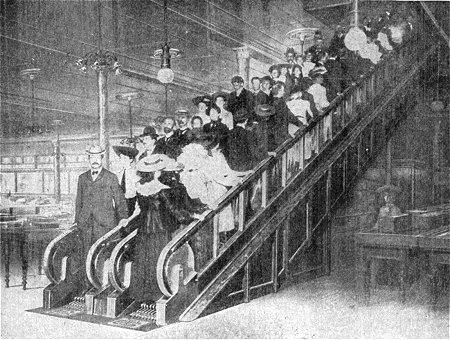Magic Stairways
Today, magic stairways. The University of Houston's College of Engineering presents this series about the machines that make our civilization run, and the people whose ingenuity created them.
Escalators were rare when I was young. It was heady adventure for a six-year-old to visit the one downtown department store that had one. Still the concept was already an old one in the 1930s. An escalator with features we know today was patented by Nathan Ames in 1859. It even had a form of the comblike structure that lets steps emerge out of the floor, then vanish back into it.
Ames's escalator never got built. We wouldn't have electric motors to drive them until the 1880s. Some of the taller buildings had steam-driven elevators at the time, but who would install a whole steam engine just to power an occasional stairway? Steadily moving escalators make sense only for steady flows of people.
Consider where we see escalators today: They're used in department stores, or by crowds of people using shops near the bottom of very tall buildings. (Mid-19th-century buildings weren't ever more than about seven stories high.) Escalators carry people between airplane or subway gates and the street level. None of that existed.
So, the escalator idea lay fallow until the 1890s. Then a spate of electric-powered moving stairways appeared. The first was a 6-foot stairway, built by Jesse Reno to lift people onto the Coney Island pier. Right on its heels, the 1900 Paris Exhibition displayed four different kinds of escalators -- including Reno's.
The Coney Island success made Reno into America's leading escalator designer. From Coney Island his machines went into New York department stores, then the new Boston subways. Otis Elevator Company bought Reno out. Even then, escalators hovered in the novelty fringe. They were catchy, but they still seemed more like a fairground ride than functional necessity. By 1921 no escalator company operated more than 200 units.
Then the Otis Company, having studied features of competing systems, sifted out the best and created the standard escalator design we know today -- a machine that can carry 8000 people an hour up a 30 percent slope. Only then were escalators on the way to becoming common-place. Only then did they fully reveal the real role they'd play in our lives. They're less labor savers than they are space savers. They keep people moving in crowded public places. And that's also true of their cousin, the moving sidewalk.
Yet the old Reno escalator was a solid piece of equipment. Many are still in use. You see them in Boston and London subway systems. Their treads and risers have a characteristic structure of wooden slats. By the way, Reno joined with another inventor in 1906 to build a spiral escalator. It didn't catch on then; but Mitsubishi now builds spiral escalators. They're running in many big cities, although I've yet to see and experience one.
When I was six, I reveled in the high adventure of being swept upward. Who would've thought that, seventy years later, I'd be anticipating my first ride on yet another form of those same magical, self-acting stairways.
I'm John Lienhard, at the University of Houston, where we're interested in the way inventive minds work.
W. Worthington, Jr., Early Risers. American Heritage of Invention and Technology, Winter, 1989, pp. 40-44.
J. H. Lienhard, Inventing Modern: Growing up with X-Rays, Skyscrapers, and Tailfins. (New York Oxford University Press, 2003): Chapter 6.
See also: https://en.wikipedia.org/wiki/Escalator
This is a greatly revised version of Episode 250.

Early photo of a Reno type of escalator